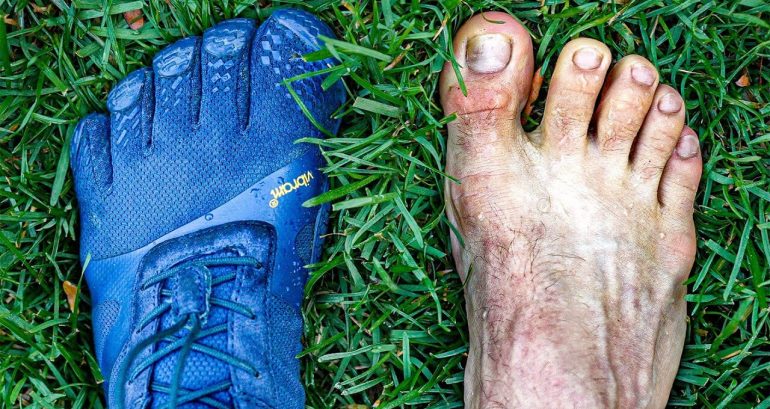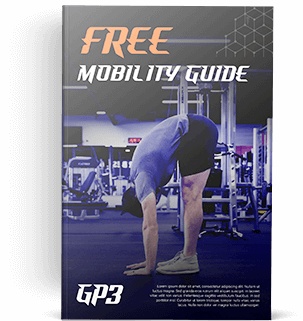Key Points:
1. Most people’s shoes and running form contribute massively to foot problems.
2. The answer is NOT orthotics and more cushioned shoes.
3. One step that’s absolutely vital is to train your feet, just like you would any other muscle group.
Estimated reading time: 4-8 minutes
Sometimes I’m struck by the absurdities of modern life. There are things we accept as normal that make no sense when you think about them for more than 30 seconds.
For example, why does your credit score (temporarily) go down when a lender formally inquires into it? That’s exactly when you need it to be highest! Or, why does your insurance premium go up when you get into a car accident? Isn’t the whole point that a vast majority of the time, you pay for insurance without using it…so that there’s a pool of money there when you do need it?
Obviously, a cynic will say, “Duh. It’s so that lenders and insurance companies can make more money off you.”
Well, that’s likely true, so let me phrase this in a different way. Why do we accept these things? Leaving aside the general futility of today’s partisan politics, society sometimes can and does change things that we realize are, well, a load of garbage.
For instance, yes, it took a pandemic to get us there, but look at how common remote work is now. Even five years ago, how many companies would have said, “We can’t let employees stay home. Nothing will get done!”
In a more graphic example, a couple centuries ago, it was common practice for drinking water and sewer systems to use the same pipelines. You can imagine the disgusting and horrific consequences this had on public health, so we changed it!
It probably started with someone asking, “Hmm…why do we accept drinking dirty, contaminated water?” They probably then used their best Shark Tank voice and declared, “There HAS to be a better way.”
Well, today I’ve got another question for you.
Why aren’t shoes shaped like feet?
I’ll do my best to describe this with text, but just take a look at this picture and this one if you’re not sure what I mean.
Basically, the human foot is supposed to be at its widest at the transverse arch, or what we typically call the ball of the foot. And yet, this is exactly where shoes start to dramatically narrow. Over time makes our feet conform to the shape of our footwear.
Here’s the odd thing. There isn’t actually any reason shoes should look like this. It all comes down to aesthetics. At some point, it was arbitrarily decided that narrow shoes with a raised heel looked “better” than ones that were flat and appropriately wide. Apparently we haven’t come that far from foot binding after all.
Now, wearing trendy shoes obviously isn’t as nearly as detrimental to your feet as this, but it’s still pretty damaging. It leads to bunions, collapsed arches, hammer toes, and all kinds of other painful consequences.
So, what can we do about this?
Just wear orthotics, right? Wrong!
The answer the footwear industry has seemingly decided upon is more cushioning and more support. Heck, kids as young as three years old are being prescribed orthotics! Here’s the problem though.
Orthotics are just a band-aid. They don’t fix the underlying issue of weak, immobile feet.
Let’s look at a fun little trivia question.
What is the weakest part of an arch?
If you’re not an engineer, the answer may surprise you. Hint: it’s not the middle. The weakest portion of an arch is actually the outsides. The center is, in fact, the strongest. So, all orthotics are doing is reinforcing the part least in need of reinforcement.
Even worse, the body adapts to the extra support by letting the orthotics do the job the arches are supposed to do. Why waste energy when you don’t need to, right? But, this extra support should never be a long term solution.
Imagine if you injured your ankle and the doctors told you that the fix was for you to be on crutches for the rest of your life. You’d probably push back against that, wouldn’t you? Well, being stuck in orthotics and cushioned shoes is basically the same thing.
Instead of strengthening our feet, we give them more and more cushion and support, thus perpetuating the vicious cycle of weak feet and foot pain.
And it’s fast becoming an epidemic. It’s estimated that up to 30% of adults suffer from foot pain.
So, how the heck did we get here?
A Brief History of Jogging
It may seem strange to us now, but “jogging” was actually invented in the late 1960’s and popularized in the 70’s. This clip from Anchorman isn’t just funny, it’s also historically accurate! A track coach from New Zealand named Arthur Lydiard invented jogging as a hybrid of running and walking. An American coach named Bill Bowerman subsequently learned about this training method from him in the late 1960’s and popularized it in the U.S.
Unfortunately, the intentionally heel-toe running style of jogging is one of the worst things you can do for your body. When running, you absorb the force of roughly triple your bodyweight with each stride. Also, our heels are only meant to apply braking force for deceleration. If they’re the first point of contact, we’re doing the human equivalent of driving with the parking brake on.
Sure, you can do this, and still even move around pretty quickly, but there are going to be inevitable and detrimental consequences.
With our bodies, these inevitable consequences include all the force of each stride skipping the force-absorbing mechanisms built into our feet and lower legs, and then traveling up the chain into our ankles, knees, hips, and lower backs.
So, when jogging burst onto the scene, millions of people started getting injured.
Enter Nike, and the development of the modern running shoe.
Interestingly enough, the same Bill Bowerman who brought jogging to the US also co-founded Nike.
Now, I’m not going to go all tinfoil hat on you here. I definitely do not believe a detrimental form of exercise was introduced so that a multibillion dollar shoe industry could be created to fix a problem that didn’t previously exist. Instead, I think Lydiard and Bowerman probably thought they were doing something good for the average person, theoretically making running more approachable for beginners.
Then, when the practice didn’t match the theory and people started getting hurt, creating more supportive shoes was the next natural step.
Unfortunately, this has gone way too far. As a consequence, most of us are walking around with stiff, weak feet and no idea what to do about it.
So, what can we do about it?
For starters, train your feet like you would any other muscle group!
There are 26 bones, 33 joints, and over 100 muscles, ligaments, and tendons in the feet. How can we neglect them and expect to move well? A good parallel is the hands. Imagine how much function we’d lose if we wore stiff mittens that smashed our fingers together for most of our waking hours. Given that we know a strong grip is associated with longevity, it’s a relief we don’t do that. But with our typical footwear choices, most of us unknowingly do something similarly harmful to our feet.
So, start training your feet! If you’re not sure where to begin, look here. These five simple but deceptively challenging exercises provide the first steps (tee hee) to stronger, more mobile feet. Then, if you’re looking to transition away from what are essentially cushioned foot casts, check out Anya’s Shoe Reviews. Her site has an incredible array of free resources all about taking better care of our feet.
Even better, she offers reviews of nearly every type of barefoot shoe that currently exists. Turns out, some enterprising companies have decided the answer to my question of, “Why aren’t shoes shaped like feet?” is… “There are now!”
And luckily, there are even dozens of ever more-stylish options, so that you don’t have to be the weirdo wearing 5-toed shoes. But if you want, that’s cool too. I’ll admit I bought a pair. I even sometimes muster up the courage to wear them in public. It doesn’t really matter, though.
However you go about it, this is one modern absurdity we’re on our way to fixing.
Before you go, I’d love to hear from you! Do you have any experience with minimalist, “barefoot” shoes? Have you ever tried strength-training exercises for your feet? Reply to this email and let me know!

